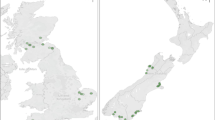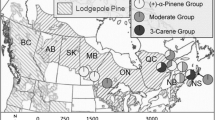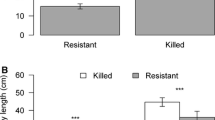Abstract
Introduced forest tree species are frequently attacked by insects in their new range; however, it has been seldom investigated whether the presence of such tree species increases the risk of range expansion of native insect herbivores in the introduced range. European Scots pine has been introduced to North America including within a portion of the range of the mountain pine beetle (MPB). We investigated Scots pine suitability to MPB as a host in the introduced range of the pine populations. We compared chemotypic similarity of foliage between introduced and native Scots pine populations, and then determined the suitability of introduced populations to MPB. Suitability was assessed based on whether beetles produce aggregation pheromone components and complete development in Scots pine bolts. We also assessed whether or not suitability was affected by the host chemotypes. Introduced and native pine populations had the same sesquiterpene chemotypes and shared one of the two monoterpene chemotypes. All introduced populations were suitable for MPB but the suitability varied slightly with host chemotype. This is the first report of chemotypic variations of Scots pine populations outside its native range. Chemotypic similarity between the introduced and native pine populations, ability of beetles to produce pheromones and to complete its life cycle on bolts from all chemotypes, and preferential colonization of Scots pine over native pine species by MPB in field suggest that introduced Scots pine populations could facilitate transcontinental expansion of MPB in North America.






Similar content being viewed by others
References
Bates D, Maechler M, Bolker B, Walker S (2015) Fitting linear mixed-effects models using lme4. J Stat Soft 67:1–48
Bentz BJ, Jönsson AM, Schroeder M, Weed A, Wilcke RAI, Larsson K (2019) Ips typographus and Dendroctonus ponderosae models project thermal suitability for intra- and inter-continental establishment in a changing climate. Front For Glob Change 2:1. https://doi.org/10.3389/ffgc.2019.00001
Blomquist GJ, Figueroa-Teran R, Aw M, Song M, Gorzalski A, Abbott NL, Tittiger C (2010) Pheromone production in bark beetles. Insect Biochem Mol Biol 40:699–712
Borden JH, Pureswaran DS, Lafontaine JP (2008) Synergistic blends of monoterpenes for aggregation pheromones of the mountain pine beetle (Coleoptera: Curculionidae). J Econ Entomol 101:1266–1275
Branco M, Brockerhoff EG, Castagneyrol B, Orazio C, Jactel H, Saura S (2015) Host range expansion of native insects to exotic trees increases with area of introduction and the presence of congeneric native trees. J Appl Ecol 52:69–77
Brockerhoff EG, Liebhold AM (2017) Ecology of forest insect invasions. Biol Invasion 19:3141–3159
Byers JA, Wood DL, Craig J, Hendry LB (1984) Attractive and inhibitory pheromones produced in the bark beetle Dendroctonus brevicomis during host colonization: regulation of inter- and intraspecific competition. J Chem Ecol 10:861–878
CABI/EPPO (2019) Bursaphelenchus xylophilus (pine wilt nematode). Datasheet 10488. Last visited 12 Nov 2019. https://www.cabi.org/isc/datasheet/10448
Cale JA, Taft S, Klutsch JG, Sweeney JD, Erbilgin N (2015) Mountain pine beetle (Dendroctonus ponderosae) can produce its aggregation pheromone and complete brood development in naïve red pine (Pinus resinosa) under laboratory conditions. Can J For Res 45:1873–1877
Chiu CC, Keeling CI, Bohlmann J (2017) Toxicity of pine monoterpenes to mountain pine beetle. Sci Rep 7:8858. https://doi.org/10.1038/s41598-017-08983-y
Chiu CC, Keeling CI, Bohlmann J (2018) Monoterpenyl esters in juvenile mountain pine beetle and sex-specific release of the aggregation pheromone trans-verbenol. Proc Nat Acad Sci USA 115:3652–3657
Cudmore TJ, Björklund N, Carroll AL, Lindgren BS (2010) Climate change and range expansion of an aggressive bark beetle: evidence of higher beetle reproduction in naïve host tree populations. J Appl Ecol 47:1036–1043
Cullingham CI, Cooke JEK, Dang S, Davis CS, Cooke BJ, Coltman DW (2011) Mountain pine beetle host-range expansion threatens the boreal forest. Mol Ecol 20:2157–2171
Erbilgin N (2019) Phytochemicals as mediators for host range expansion of a native invasive forest insect herbivore. New Phytol 221:1268–1278
Erbilgin N, Ma C, Whitehouse C, Shan B, Najar A, Evenden ML (2014) Chemical similarity between historical and novel host plants promotes range and host expansion of the mountain pine beetle in a naive host ecosystem. New Phytol 201:940–950
Erbilgin N, Cale JA, Hussain A, Ishangulyyeva G, Klutsch JG, Najar A, Zhao S (2017) Weathering the storm: how lodgepole pine trees survive mountain pine beetle outbreaks. Oecologia 184:469–478
Evans HF, McNamara DG, Braasch H, Chadoeuf J, Magnusson C (1996) Pest risk analysis (PRA) for the territories of the European Union (as PRA area) on Bursaphelenchus xylophilus and its vectors in the genus Monochamus. Bull OEPP 26(2):199–249
Forrest GI (1980) Genotypic variation among native Scots pine populations in Scotland based on monoterpene analysis. Forestry 53:101–128
Fraser SM, Lawton JH (1994) Host range expansion by British moths onto introduced conifers. Ecol Entomol 19:127–137
Fries A (2016) Damage by pathogens and insects to Scots pine and lodgepole pine 25 years after reciprocal plantings in Canada and Sweden. Scan J For Res 32:459–472
Furniss MM, Schenk JA (1969) Sustained natural infestation by the mountain pine beetle in seven new Pinus and Picea hosts. J Econ Entomol 62:518–519
Futai K (2013) Pine wood nematode, Bursaphelenchus xylophilus. Annu Rev Phytopath 51:61–83
Goßner MM, Chao A, Bailey RI, Prinzing A (2009) Native fauna on exotic trees, phylogenetic conservatism and geographic contingency in two lineages of phytophages on two lineages of trees. Am Nat 173:599–614
Gries G, Leufvén A, Lafontaine JP, Pierce HD Jr, Borden JH, Vanderwel D, Oehlschlager AC (1990) New metabolites of α-pinene produced by the mountain pine beetle, Dendroctonus ponderosae (Coleoptera: Scolytidae). Insect Biochem 20:365–371
Guevara-Rozo S, Classens G, Hussain A, Erbilgin N (2019) Short-and long-term cold storage of jack pine bolts in associated with higher concentrations of monoterpenes and nutrients. Can J For Res 49:305–308
Hennig C (2018) fpc: flexible procedures for clustering R package version 21-11. https://cran.r-project.org/package=fpc
Hunt DWA, Borden JH (1990) Conversion of verbenols to verbenone by yeasts isolated from Dendroctonus ponderosae (Coleoptera: Scolytidae). J Chem Ecol 16:1385–1397
Hunt DWA, Borden JH, Lindgren BS, Gries G (1989) The role of autoxidation of α-pinene in the production of pheromones of Dendroctonus ponderosae (Coleoptera: Scolytidae). Can J For Res 19:1275–1282
Kännaste A, Copolovici L, Pazouki L, Suhhorutsenko M, Niinemets Ü (2013) Highly variable chemical signatures over short spatial distances among Scots pine (Pinus sylvestris) populations. Tree Physiol 33:374–387
Klutsch JG, Najar A, Cale JA, Erbilgin N (2016) Direction of interaction between mountain pine beetle (Dendroctonus ponderosae) and resource-sharing wood-boring beetles depends on plant parasite infection. Oecologia 182:1–12
Kuznetsova A, Brockhoff PB, Christensen RHB (2017) lmerTest Package: Tests for linear mixed effects models. J Stat Soft 82:1–26
Leufvén A, Bergström G, Falsen E (1984) Interconversion of verbenols and verbenone by identified yeasts isolated from the spruce bark beetle Ips typographus. J Chem Ecol 10:1349–1361
Lindelöw Å, Björkman C (2001) Insects on lodgepole pine in Sweden—current knowledge and potential risks. For Ecol Manag 141:107–116
Manninen AM, Tarhanen S, Vuorinen M, Kainulainen P (2002) Comparing the variation of needle and wood terpenoids in Scots pine provenances. J Chem Ecol 28:211–228
McCambridge WF (1975) Scotch pine and mountain pine beetles. The Green Thumb 32: 87. Denver Botanic Gardens; Colorado Forestry and Horticultural Association. https://archive.org/details/greenthumb3219unse/page/87
Muona O, Hiltunen R, Morén E, Shaw DV (1986) Analysis of monoterpene variation in natural stands and plus trees of Pinus sylvestris in Finland. Silva Fenn 20:1–8
Niemelä P, Mattson WJ (1996) Invasion of North American forests by European phytophagous insects. Bioscience 46:741–753
Paine TD (2006) Invasive forest insects, introduced forest trees, and altered ecosystems: ecological pest management in global forests of a changing world. Springer, The Netherlands
Paule L, Yazdani R (1992) Geographical variation in monoterpene composition of foliar oleoresin in Swedish populations of Picea abies. Scan J For Res 7:27–37
Pearse IS, Harris DJ, Karban R, Sih A (2013) Predicting novel herbivore–plant interactions. Oikos 122:1554–1564
Pureswaran DS, Sullivan BT (2012) Semiochemical emission from individual galleries of the southern pine beetle, Dendroctonus frontalis Zimmermann (Coleoptera: Curculionidae: Scolytinae), attacking standing trees. J Econ Entomol 105:140–148
R Core Team (2017) R: a language and environment for statistical computing R Foundation for Statistical Computing Vienna Austria. https://www.R-projectorg
Raffa KF, Berryman AA (1983) The role of host plant resistance in the colonization behavior and ecology of bark beetles (Coleoptera, Scolytidae). Ecol Monog 53:27–49
Raffa KF, Mason CJ, Bonello P, Cook S, Erbilgin N, Keefover-Ring K, Klutsch JG, Villari C, Townsend PA (2017) Defence syndromes in lodgepole-whitebark pine ecosystems relate to degree of historical exposure to mountain pine beetles. Plant Cell Environ 40:1791–1806
Reid ML, Sekhon JK, LaFramboise LM (2017) Toxicity of monoterpene identity, diversity, and concentration to mountain pine beetles, Dendroctonus ponderosae: beetle traits matter more. J Chem Ecol 43:351–361
Roques A, Auger-Rozenberg M-A, Boivin S (2006) A lack of native congeners may limit colonization of introduced conifers by indigenous insects in Europe. Can J For Res 36:299–313
Rosenberger DW, Venette RC, Maddox MP, Aukema BH (2017) Colonization behaviors of mountain pine beetle on novel hosts implications for range expansion into northeastern North America. PLoS ONE 125:e0176269. https://doi.org/10.1371/journalpone0176269
Rosenberger DW, Venette RC, Aukema BH (2018) Development of an aggressive bark beetle on novel hosts: implications for outbreaks in an invaded range. J Appl Ecol 55:1526–1537
Safranyik L, Carroll AL, Régnière J, Langor DW, Riel WG, Shore TL, Peter B, Cooke BJ, Nealis VG, Taylor SW (2010) Potential for range expansion of mountain pine beetle into the boreal forest of North America. Can Entomol 142:415–442
Semiz G, Heijari J, Isik K, Holopainen JK (2007) Variation in needle terpenoids among Pinus sylvestris L Pinaceae provenances from Turkey. Biochem Syst Ecol 35:652–661
Sjödin K, Persson M, Fäldt J, Ekberg I, Borg-Karlson A-K (2000) Occurence and correlations of monoterpene hydrocarbon enantiomers in Pinus sylvestris and Picea abies. J Chem Ecol 26:1701–1720
Taft S, Najar A, Godbout J, Bousquet J, Erbilgin N (2015) Variations in foliar monoterpenes across the range of jack pine reveal three widespread chemotypes implications to host expansion of invasive mountain pine beetle. Front Plant Sci 6:342. https://doi.org/10.3389/fpls201500342
Thoss V, O’Reilly-Wapstra J, Iason GR (2007) Assessment and implications of intraspecific and phenological variability in monoterpenes of Scots pine Pinus sylvestris foliage. J Chem Ecol 33:477–491
Tobolski JJ, Hanover J (1971) Genetic variation in monoterpenes of Scots pine. For Sci 17:293–299
Walther GR, Roques A, Hulme PE, Sykes MT, Pysek P, Kühn I, Zobel M, Bacher S, Botta-Dukát Z, Bugmann H, Czúcz B, Dauber J, Hickler T, Jarosík V, Kenis M, Klotz S, Minchin D, Moora M, Nentwig W, Ott J, Panov VE, Reineking B, Robinet C, Semenchenko V, Solarz W, Thuiller W, Vilà M, Vohland K, Settele J (2009) Alien species in a warmer world: risks and opportunities. Trend Ecol Evol 24:686–693
Wood SL (1982) The bark and ambrosia beetles of North and Central America (Coleoptera: Scolytidae), a taxonomic monograph. Great Basin Natl Mem 6:1–1359
Yazdani R, Nilsson JE (1986) Cortical monoterpene variation in 10 natural populations of Pinus sylvestris in Sweden. Scan J For Res 1:85–93
Acknowledgements
Funding was provided by The Swedish Research Council Formas—Grants for Research and Development Projects and NSERC–Discovery Grant to NE. We also acknowledge that all necessary permits were in hand when the research was conducted. Collections in Ontario were made by C Emilson, M Gray, and D. Fromme.
Author information
Authors and Affiliations
Contributions
NE and MS conceived the ideas; NE designed the methodology; NE led the writing of the manuscript; JGK, GI, RR, and NE conducted chemical analysis; JAC and NE analysed the data; NE, GI, CB, TB, GJ, MH, CH, CJKM, and RS collected the data. All authors contributed critically to the drafts and gave final approval for publication.
Corresponding author
Additional information
Publisher's Note
Springer Nature remains neutral with regard to jurisdictional claims in published maps and institutional affiliations.
Electronic supplementary material
Below is the link to the electronic supplementary material.
Rights and permissions
About this article
Cite this article
Erbilgin, N., Klutsch, J.G., Najeeb, H. et al. Chemical similarity between introduced and native populations of Scots pine can facilitate transcontinental expansion of mountain pine beetle in North America. Biol Invasions 22, 1067–1083 (2020). https://doi.org/10.1007/s10530-019-02159-7
Received:
Accepted:
Published:
Issue Date:
DOI: https://doi.org/10.1007/s10530-019-02159-7




